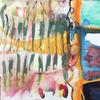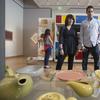'Our Metropolis: Paintings of New York City by American Artists' at Hawthorne Fine Art
- NEW YORK, New York
- /
- September 20, 2017

Hawthorne Fine Art will present a group of New York City scenes that span over a hundred years of artistic output in an exhibition titled Our Metropolis (by appointment in their Manhattan showroom) from September 21-December 8th. Beginning with the Hudson River School with the work of George Lafayette Clough (1824-1901) and Samuel Colman (1832-1920), this exhibition traverses Tonalism through the work of Gustave Wolff (1863-1935), Impressionism through the work of Paul Cornoyer (1864-1923), Laura Trevitte Horne (1891-1958) and Mary Fairchild Low (1858-1946), the Ashcan School through Ernest Frederick Meyer (1863-1952), Ernest Lawson (1873-1939) and Fritz Bachmeyr (b. 1944), and finally the Modern period of the twentieth century through the work of Marguerite Zorach (1887-1968) and Stuart Davis (1892–1964).
Truman Capote once wrote of New York City: “I love New York, even though it isn't mine, the way something has to be, a tree or a street or a house, something, anyway, that belongs to me because I belong to it.” It is a sentiment that countless creative types have experienced over the last century, many of whom have left behind portraits of the landmark city as they felt part of it.

A second-generation Hudson River School painter, Samuel Colman frequently painted his native New York City, where he had moved in his youth. In Governors Island, New York Harbor from 1875, the low horizon and Colman’s silvery waters reflect the influence of the Dutch School, whose work he would have seen during his 1871 travels through Holland. In this harbor scene, which subtly suggests industrial activity, of New York City’s most important commercial spaces is portrayed at a rare moment of calm. The same can be said for George Lafayette Clough’s Balcony Arch Bridge, Central Park (c. 1885), which captures the burgeoning public park. Painted after the completion of the Balcony Bridge in 1860, Clough’s work also depicts a leisure spot at a tranquil moment. As illustrated in an 1871 guide The Metropolis Explained, the flattopped, aqueduct style Balcony Bridge was a popular sight. Clough’s vista is reminiscent of early images of Central Park which called upon Victorian modes of ‘promenading’ in a natural environ designed by the era’s leading landscape architect, Frederick Olmsted.

In the works by Gustave Wolff, who relocated to New York City in the 1910s to expand his artistic horizons, the artist depicts scenes unique to his new city: the 79th Street Boat Basin on the west side, known for its distinct views of the Hudson River, the now-lost Wheelock Mansion on 158th Street, and the wintery landscape in Harlem at the time, which was not yet fully developed. These vistas, each softly rendered in the fading light of day, present a turn of the century vision of New York City on the brink of economic expansion in the pale, crystalized vocabulary of Tonalism. Wolff had left his hometown of St. Louis to make a name for himself in the country’s most competitive metropolis and as such his works exhibit both the technical skill he developed earlier in his career and his nascent love of his new city. Crucial here is Wolff’s decision to depict New York City’s historical locations at a moment when it was rapidly evolving – an action that safeguards the city’s past and also gestures toward its future.
At the turn of the twentieth century, artists approached the landscape of New York City from increasingly diverse viewpoints. Early Evening, Empire Park, New York (c. 1910) by Paul Cornoyer, who had relocated to New York City in 1899, captures a small park near Lincoln Center (now known as Richard Tucker Square) at twilight. The atmosphere of dusk combined with the park’s few remaining figures deftly express the experience of the end of the day. Meanwhile another artist of this period, Laura Trevitte Horne, embraced the bold colors of the flourishing flora in the city’s public spaces in Spring in Central Park. Horne’s ruddy oranges and brilliant greens contrast substantially with the work of another female artist of the same period, Mary Fairchild Low. In Low’s Ships in the Hudson River, January 20th, 1919 (1919), the artist focuses on the icy prowess of the city’s major commercial river during the period of WWI.
During the period of the Ashcan School, realistic scenes drawn from mundane experiences were increasingly prized. Ernest Lawson’s On the Harlem River certainly shows the influence of the Ashcan style in the presence of the warehouse along the river depicted; while the majority of the work was painted in the sketchy Impressionism of the Barbizon School, the warehouse is painted in the gritty realism of the Ashcan painters like Robert Henri. Similarly, in New York Street Scene, Ernest Frederick Meyer uses thick, broad brushstrokes to convey the movement of a bustling city street. The lack of detail here builds ambience and universalizes the scene.
In the 1930s, while the rest of the country was recovering from the Great Depression of 1929, New York City was booming. As author Leslie Charteris wrote in 1935 in The Saint in New York, “before them was spread out the ragged panorama of south Manhattan, the wonder island of the West.” It is during this period that one can see the rise of the image of the skyscraper and all its connotations of commerce and progress. In Stuart Davis’s drawing Lower Manhattan (ca. 1930), the regularity of the new city-scape is splayed out before us. Conversely, in another painting done in New York at during this period by Marguerite Zorach of her cats on the stairs at her apartment on 10th Street in Greenwich Village, the artist presents an interior view of city life. While artists painted in the comfort of their home studios, the city continued to rise around them.
By the mid to late twentieth century, New York City scenes had become a genre in its own right. In Fritz Bachmeyr’s Snow Scene in Brooklyn, NY, the artist captures the unique experience of commuting in the fully maturated metropolis. Framed by the Manhattan bridge, Bachmeyr’s figures brace themselves against the biting winds of winter (the least ideal season to be living in the city). Informed both by the airy style of French Impressionism and the coarse subjects of the Ashcan School, Snow Scene in Brooklyn, NY demonstrates how painting a New York City landscape more often than not led to stylistic innovations built on historical precedent.












100x100_c.jpg)


